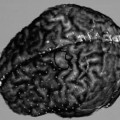
Intraoperative Image Update by Interface with Ultrasound
Despite advances in medical imaging techniques and their routine preoperative use, real-time intraoperative information regarding anatomy remains of significant importance to the neurosurgeon. Accurate localization of neurosurgical targets is essential to minimize surgical morbidity. To reach this goal, ultrasound was extensively used in neurosurgical procedures during the last quarter of the twentieth century, and the echogenic characteristics of various lesions were defined.1 In addition, the quality of ultrasound images has improved significantly with newer technologies, and greater penetration at higher frequencies is achieved with new signal encoding techniques.
Ultrasound’s most important advantage is its capability to depict in real time the anatomical characteristics of the surgical field. Furthermore, it does not require radiation, it is easy to use, and it is relatively inexpensive. Real-time information obtained from ultrasound images is helpful during both cranial and spinal procedures. Intraoperative ultrasound has been used to localize subcortical and deep lesions including tumors, abcesses, and hematomas; to define tumor margins; to evaluate the completeness of resection; and to determine the presence of surgical complications. During spinal procedures, a higher-frequency ultrasound probe may be used to verify that the bone removal is adequate to expose the entire solid component of a tumor. In addition, intramedullary lesions as well as pathologies located anterior to the spinal cord may be visualized by intraoperative ultrasonography.2
 Neuronavigation
Neuronavigation
The development of neuronavigation systems was another major technical advance in neurosurgery. Neuronavigation methods help the neurosurgeon in planning surgery and approaching the tumor as well as during resection and in evaluating the extent of resection. Although conventional neurosurgery training and subsequent experience enable the surgeon to navigate safely within the brain parenchyma, additional intraoperative anatomical information is valuable, especially in situations where individual anatomical variations or prior treatment complicates the anatomy. Tumors, together with their surrounding edema, often distort normal anatomical relationships and thus pose a significant challenge to the neurosurgeon trying to navigate using conventional landmarks. Intraoperative image guidance may also provide critical information during resection of tumors with a consistency similar to normal brain tissue by delineating T2-weighted imaging margins.
The primary components of any contemporary navigational system include registration of the surgical target with respect to surrounding structures and physical space, interacting with a localization device, integration of real-time data, and interfacing with a computer.3 Data from multiple images can be integrated using either natural landmarks or external fiducial markers. Frameless stereotactic navigation systems include ultrasonic digitizer systems, magnetic field digitizers, multijointed encoder arms, infrared flash systems, and robotic systems. Multiple registration techniques are available to map images with respect to each other and to the surgical field. Regardless of the preferred registration method, frameless systems may provide an advantage over framebased systems in defining precise localization because distortions of imagery are likely to be reflected in the landmarks as well as in the anatomy of interest. In addition, because frameless systems do not require fixation to an immobile frame, they may be used for craniotomies and spine surgeries. Several frameless stereotactic systems are now available for use in procedures together with ultrasound and light-emitting diode (LED)-based localization or with magnetic field-based tracking systems.4–5
Accuracy of a frameless stereotactic system using an instrument holder was assessed for images acquired using magnetic resonance (MR) or computed tomography (CT) scans.6 In the first phase of the study, which consisted of 258 laboratory measurements on phantom frameless stereotactic procedures, a mean error of 1.1 ± 0.5 mm was found for CT-guided procedures, whereas the mean error rate was 1.4 ± 0.7 mm for MR-based stereotactic procedures. The clinical phase of the study, conducted on 21 procedures for intracranial mass lesions, revealed a mean linear error of 2.6 ± 1.9 mm and 2.5 ± 0.7 mm for MR and CT, respectively. In another study, the authors evaluated target-localizing accuracy of a neuronavigational system with passive optical tracking where reflection of infrared flashes from reflectors placed on surgical instruments was tracked by camera arrays.7 In a study population of 125 patients with mostly tumor patients, a mean error rate of 4 ± 1.4 mm was detected.
 Sononavigation
Sononavigation
Alteration of the surgical anatomy of the lesion and surrounding structures may be the result of intraoperative displacement of the brain tissue due to surgical retraction or the resection cavity itself, as well as the shift caused by cerebrospinal fluid leakage. Roberts et al8
Stay updated, free articles. Join our Telegram channel

Full access? Get Clinical Tree



